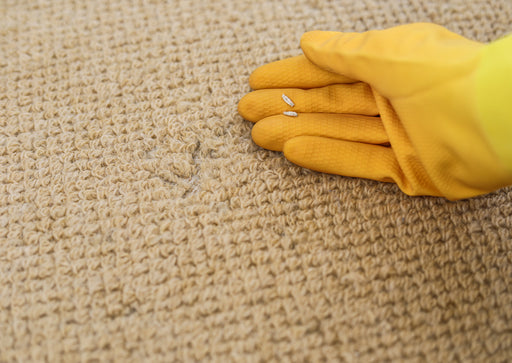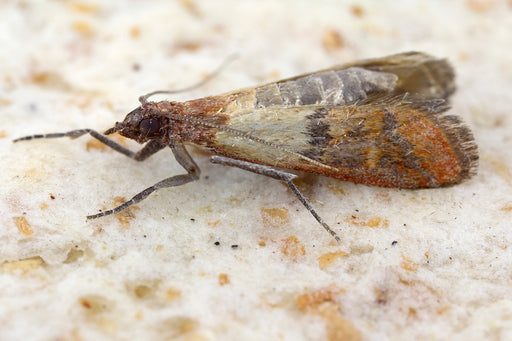Pantry Moth vs Carpet Moth: They're Not The Same Thing

Few people are ever thrilled to find moths in their house. After all, these pestilent little insects can wreak havoc on all sorts of household items, including pantry commodities, natural fiber clothing, carpets, furniture, and more. It goes without saying that you will want to rid yourself of these winged home invaders as soon as possible.
However, to remove these pests, knowing the difference between a Pantry Moth and a Carpet Moth is important. After all, before you can effectively eliminate these moths and their larvae from your home, you will need to identify the type of insect infestation that you are dealing with. This begs the question: What are the differences between the Pantry Moth and the Carpet Moth?
Although Pantry and Carpet Moths have many similarities, these insects also have some distinctive disparities. Pantry Moths (otherwise known as Indian Meal Moths) are in the family Pyralidae. In contrast, Carpet Moths belong to the family Tineidae. Each type of moth generally prefers to consume different materials in the larval stage. As larvae, Pantry Moths are known for eating stored or expired dry food goods like flour, cereals, grains, oats, etc. Alternatively, Carpet Moths can destroy carpets, furniture, tapestries, and other items that may contain animal-based fibers in their quest for sustenance.
To truly understand how Carpet Moths and Pantry Moths compare, it can be helpful to comprehend their habits, life cycles, and behaviors. That way, you will be able to completely eradicate any infestation at its source, not to mention, prevent it from recurring using Moth Traps and other measures properly.
To make things easier, let’s go over everything you need to know about Pantry Moths versus Carpet Moths so that you can rid your household of either type of infestation.

Carpet Moths vs Pantry Moths: A Side-by-side Comparison
As previously stated, Pantry and Carpet Moths belong to different insect subspecies and categories. In the moth species family called Pyralidae, the scientific name for the Pantry Moth is Plodia Interpunctella. The scientific name for the Carpet Moth is Trichophaga Tapetzella, and these insects are of the family Tineidae. Both moths eat different materials as larvae, and thus, are attracted to different things and can be found in varying areas throughout the home.
Pyralids (Grain Moths)
The moth family Pyralidae consists of Pyralid moths like Grass Moths, Snout Moths, and other Lepidoptera insects that eat through grains and plant fibers in their larval phase.
This means that Pantry Moth Larvae will eat through an array of natural plant-based items like grain, corn, wheat, and more. Pantry Moths have even been known to eat through materials like cardboard, paper, and wicker.
Tineids (Clothes/Carpet Moths)
Tineidae moths are also in the order Lepidoptera. However, unlike Pantry Moth Pyralidae, Tineid moth larvae consume detritus, fungus, and animal-based fibers which contain keratin proteins. So clothes and textiles that are made from wool, silk, feathers and leather are all at risk from these types of larvae. Common Clothes Moths, Case-Bearing Clothes Moths, and Carpet Moths are all in the Tineidae category.
Interestingly enough, a certain moth in this category known as Ceratophaga commonly consumes keratin derived from animal hooves, which can include carpet glue.
Identifying Pantry and Carpet Moth Larvae and Adults
Telling the difference between Carpet Moths and Pantry Moths can be a little bit tricky. This is due to the fact that both types of moths have muted color tones (brown, beige, gray, etc.) and arguably unremarkable patterns. Both moths also have similar fringed or tattered-looking forewings and hindwings. However, adult Pantry Moths are easily distinguishable by their pointed snouts.
Moreover, many types of Pantry Moths also have light-colored mid-sections, with darker heads, and dark brown or black points at the back of their forewings. This pattern is usually reversed on adult Carpet Moths, which have lightly colored heads, a darker mid-section, and lighter colors on the rear end of their forewings.Telling the difference between the larvae of these moths (which cause
the most damage in homes) can be even more difficult. Both types of larvae resemble small brown, beige, yellow, or even creamy white, caterpillars, depending on their age and growth levels. However, Carpet Moth Larvae are usually cream-colored for the majority of the larval stage.

The easiest way to tell the difference between Carpet Moth Larvae and Pantry Moth Larvae is to use contextual clues. For instance, take a look at where the larvae are hiding. Are there little worms in your flour canister? If so, you are probably dealing with the larvae of a Pantry Moth.
However, insects making threadbare patches on your living room carpets or chewing through the furs you have in storage are more likely to be Carpet Moth larvae or some other species from the keratin-consuming Tinedae family.
Everything to Know About Pantry Moths
As the name suggests, Pantry Moths enjoy making a home in your pantry. Adult female Pantry Moths get into houses in search of a suitable place to lay eggs. The tiny eggs of the Pantry Moth then hatch into larvae, which can infest stored dry goods and food items.
Pantry Moth Larvae can eat things like flour, cereal, cornmeal, grain, spices, pet foods, birdseed, starches, packaging materials, and an array of other plant-based goods as they mature and grow into adults. Then, these moths mate, lay eggs, and repeat the cycle.
This means that many generations of Pantry Moths are capable of existing in a single food tote, provided that it is filled with plenty of edible goods for the larvae to eat. For this reason, it is important to identify and eliminate a Pantry Moth infestation as soon as you can.
What Causes Pantry Moths?
Pantry Moths are caused by a range of factors and may infest homes for numerous reasons. One thing is for sure, the primary cause of a Pantry Moth infestation is the presence of unsealed edible dry goods for the larvae to eat.
Sometimes, a female Pantry Moth will simply fly in through an open window and proceed to lay her eggs in a bag of oats on your highest pantry shelf. Expired items are more likely to attract Pantry Moths, as they have usually been left unattended for longer periods. Pantry Moths are not attracted to light, instead preferring dark, undisturbed areas.
In other situations, Pantry Moth Eggs may already be in the corners of an item’s packaging, even if an item is brand new and unopened before it ever leaves the store. Pantry Moth Eggs are very hard to see with the naked eye, after all. If eggs were laid by a female Pantry Moth at a packaging, processing, or shipping facility, then you could unwittingly carry them into your home after a shopping trip.
So, even if an item is not expired, do still check for signs of moths like larvae or damage to the corners of the packaging, especially in the case of bulk grain items. Don’t discount sealed packages too, ,as sealed pet food and birdseed bags can sometimes contain live larvae!
What if I have Pantry Moths in the Bedroom?
Usually, Pantry Moths can be found in kitchen cupboards, pantries, drawers, and other areas where food items are stored. But what if you notice Pantry Moths in bedroom or closet storage areas? In this case, the first thing to do is check for the presence of edible materials and food items in the vicinity.

The larvae of the Pantry Moth seek out food sources to eat as they grow and mature. As such, if you notice Pantry Moths in your bedroom, there's a good chance that you have a food source somewhere nearby that the larvae are feeding on. Think hard; do you have granola bars stored in a drawer somewhere? Maybe, a crumbled-up pastry fell behind your bed. Search for any food items in your bedroom that these larvae could be consuming. Most likely, once you locate the old food, you will also uncover the main source of the moth infestation.
If you absolutely do not have any food stashed in your bedroom or closet, you may be dealing with Clothes Moths or Carpet Moths, rather than Pantry Moths. These Tineidae moths consume animal-based fibers, which can come from wool, silk, and leather, all of which are commonly found in bedrooms and closet spaces.
Signs of Pantry Moths Include:
- Dead or live larvae in grain bins or dry good containers
- Tears/damage on the corners of packaging including bags and cardboard boxes
- Adult moths (dead or alive) in drawers and cupboards
- Sticky web-like substances or shed moth casings in food
All About Carpet Moths
Carpet Moths are closely related to Clothes Moths and their larvae are known for feeding on an array of animal-based fibers that contain the protein keratin. Keratin is a protein-rich substance found in hair, skin, and many other animal products. It's the main thing Carpet Moth Larvae feed on until they mature into adults.
Once these larvae reach the adult stage, they mate and look for a place to lay their eggs where more Keratin proteins can be found. As with Pantry Moths, Carpet Moth Larvae, rather than adults, are responsible for causing the damage to carpets, tapestries, leather items, animal hides, taxidermy displays, and the like.
What Causes Carpet Moths?
Adult female Carpet Moths look for quiet dark undisturbed places to lay their eggs. This will be on or near to a source to feed the larvae. Carpets, textile furnishings, and any animal-based fibers are suitable food for hungry larvae.
Once the eggs hatch the larvae will begin consuming whatever the nearest keratin-rich food source is, whether that be a wool tapestry, a sheepskin rug, or your great uncle’s taxidermied antelope. So, the primary cause of Carpet Moths is the presence of keratin fibers, as well as a lack of well-placed moth-deterrents.

Signs of Carpet Moths Include:
- Bare patches on furniture, carpets, or tapestries
- Dead or live larvae or adults near an area where there are keratin fibers
- Larvae on the floor, usually in cracks, crevices, or dark places
FAQs for Pantry Moth vs Carpet Moth Infestations
Now that we've gone over the basic differences between Carpet Moths and Pantry Moths, let's cover a few frequently asked questions on this subject so that you can effectively eliminate either annoying pest from your abode.
How do I know if I have Carpet Moths?
Noticing unexplained holes or fraying patches on your carpet is one of the first signs of Carpet Moths. Generally, Carpet Moths prefer dark, warm, humid, rarely disturbed areas where they can lay their eggs. These kinds of places are perfect for Carpet Moth Larvae to thrive as they consume keratin fibers or animal-based glues.
Can Pantry Moths live in clothes?
Pantry Moths love dark, quiet spots where there are plenty of plant-based items like grains or cereals for their larvae to eat. This can include flour, granola, spices, and more. As such, they don’t usually dwell in closets or areas where clothes are stored. However, if you have food stored in the same area where you keep clothes in your closet, then you could theoretically have Pantry Moth issues. Still, Clothes Moths are usually to blame if you find larvae in your linen closets or holes in your sweaters.
How to tell the difference between a Clothes Moth and a Pantry Moth?
Pantry Moths have dark heads and distinctive snouts, whereas Carpet Moths tend to have lighter heads and rounded features. Moreover, Pantry Moths prefer to lay eggs in areas where food items are stored (like pantries) whilst Carpet Moths will seek out attics, basements, or warm humid places where they can feed on a protein called keratin which is found in animal-based fibers in tapestries, rugs, skins, and carpets.
Do Pantry Moths eat carpet?
No, Pantry Moths don’t eat carpet. Instead, they eat plant-based items like grains, cereals, nuts, dried fruit, flour, animal feed, etc. Carpet Moths, however, can consume carpet, especially if the carpeting implements animal-based glue or is woven with natural fibers that contain keratin like wool. Remember though that it is not the adult Moths but the Larvae of both the Pantry Moth and the Carpet Moth that do the eating.
Are Pantry Moths the same as Carpet Moths?
Pantry and Carpet Moths are not the same; each type of moth belongs to a different moth family. Pantry Moths are in the moth family Pyralidae while Carpet Moths are in the family Tineidae. As larvae, these moths eat different materials as well. Pantry Moths devour plant-based things like grains. Carpet Moths mainly consume animal-based fibers that contain keratin.

About MothPrevention
MothPrevention® speak to customers every day about their clothes moth issues - clothes moths are a species that are ever increasing and that can cause significant damage to clothes, carpets and other home textiles.
To date, we’ve helped over 250,000 customers deal with their moth problems. We have developed professional grade solutions including proprietary pheromones and trap design, not available from anybody else in the USA.





